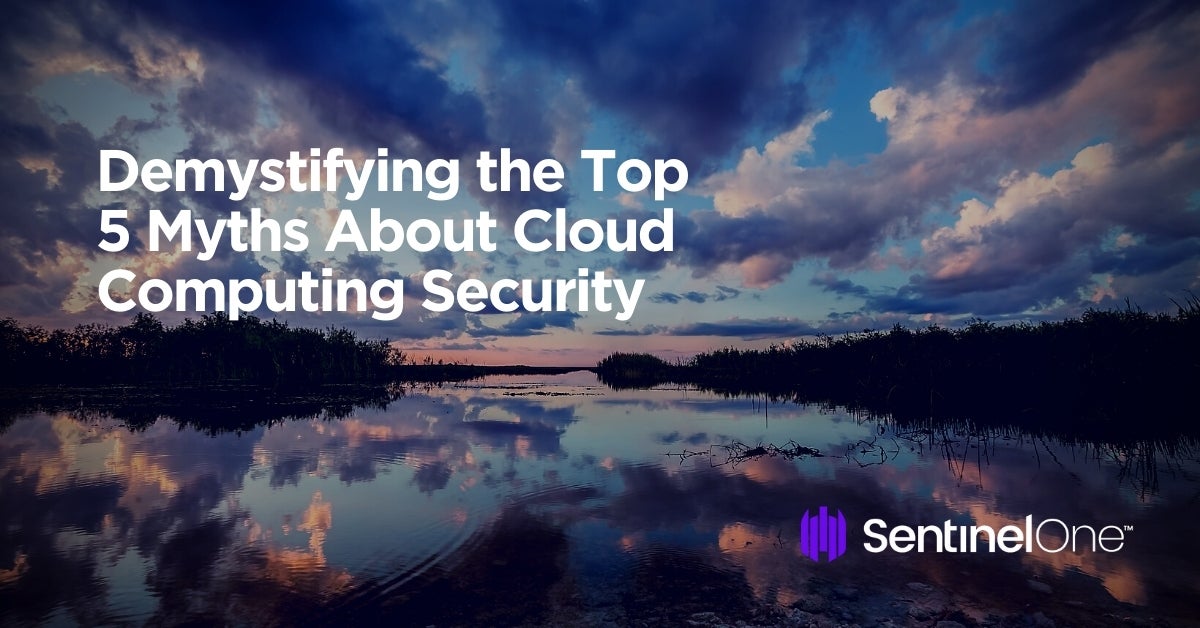Three years ago, during the global pandemic, businesses worldwide shifted their focus to delivering services digitally, supported by remote workforces and virtual environments. Many of these businesses hastily spun up cloud infrastructures to bolster critical aspects of their operations.
Threat actors saw an opportunity during this time and data breaches and cyberattacks targeting the cloud rose alongside cloud adoption. Now, leaders are shifting their focus again: This time to implement better strategies to secure the cloud infrastructures that carried them through the pandemic.
With so many myths and misconceptions surrounding cloud security, it is essential for business leaders to separate fact from fiction regarding how to secure the cloud. In this post, we debunk the top five myths about cloud computing security to help CISOs, CIOs, and other business leaders make informed decisions for their organization.

Myth #1: The Cloud is Inherently Insecure
If one were to believe the stories and opinions circulating around many technical, business, and security-focused media, it might seem that the cloud is inherently insecure. These stories tend to zero in on one aspect of cloud computing: that because it is accessible from anywhere in the world with an internet connection, it is vulnerable to cyberattacks and data breaches.
It is impossible to guarantee complete security against cyber threats. Even with advanced security measures in place, such as encryption and firewalls, there is always a possibility that an attacker can bypass these defenses and gain unauthorized access to sensitive data.
While it is true that clouds can be vulnerable to cyberattacks, it is the responsibility of Cloud Service Providers (CSPs) to ensure that the underlying machines are consistently updated and hardened against possible threats. In addition, CSPs offer various built-in security features to simplify cloud security management, such as S3 Block Public Access. By leveraging such features, DevOps engineers can effectively mitigate risks and secure their cloud infrastructure.
In fact, CSPs invest heavily in security measures to protect their customers’ data. These measures include encryption, firewalls, and multi-factor authentication (MFA), among other tools. As a result, CSPs often employ more advanced security measures than the average organization. They have dedicated security teams whose sole focus is to detect and respond to security threats and continuously improve their security posture. These security teams have access to the latest threat intelligence and are constantly monitoring their clouds for potential security breaches.
Myth #2: Cloud Providers Have Access to Your Data
One of the most persistent myths surrounding CSPs themselves is that they have unrestricted access to customer data. This myth has been fueled by examples of high-profile data breaches and incidents of unauthorized access, which have raised concerns about customer privacy and security in the cloud industry.
Though providers do need access to customer infrastructure to provide adequate services, they are bound by strict and extensive data privacy laws to ensure the confidentiality and security of that data. Cloud providers also proactively combat and mitigate risks by investing heavily in security measures and specialized teams to monitor and manage data security.
Despite the security measures, it is worth keeping in mind that customers have little control over their data once it is in the cloud, and although general malfeasance is unlikely given the obligations and regulations providers must adhere to, businesses should be aware that providers may be subject to government surveillance or other legal demands for customer data, which can compromise customer privacy and security.
Myth #3: Cloud Computing is Too Expensive
The myth that cloud computing is too expensive is often perpetuated by those who focus solely on the initial costs of implementation.
Focusing on this initial, one-time cost, however, overlooks the long-term savings and benefits that cloud computing provides. By outsourcing infrastructure maintenance to cloud providers, companies can save money on hardware, software, and staffing.
CSPs also offer scalable infrastructure that can be easily adjusted to meet changing business needs, eliminating the need for companies to maintain large, unused infrastructure. Flexible pricing models allow companies to pay only for the services they use, resulting in significant cost savings.
When organizations partner with CSPs, they can rely on their expertise and resources to get top-notch security, disaster recovery, and backup services. These services are usually difficult and expensive for many organizations to evaluate, manage, and maintain on their own.
Myth #4: The Cloud is Only for Big Businesses
The reality of understanding and using technology like cloud computing is that there is a learning curve for small businesses. The misconception, though, is that cloud is only for big businesses. Cloud computing is frequently lauded for its elasticity and has become an important technology for businesses of all sizes. It offers numerous benefits, such as scalability and cost-effectiveness.
While it may be true that some small businesses with limited budgets can struggle to justify the ongoing costs of cloud services, most reliable CSPs now offer affordable pricing plans that can be scaled up or down as needed.
It is also important for small businesses to evaluate what exactly they are looking to gain from cloud computing. The cloud offers a wide variety of services, ranging from basic file storage to big data analysis, data security, testing and development, and more. The cloud also provides small businesses with data security and disaster recovery options previously only available to large companies. In short, small businesses can leverage the cloud to compete with larger enterprises on a level playing field.
Leveraging all cutting edge technologies may be too expensive for small businesses, but they can still use the cloud to access enterprise-level technology without investing heavily in hardware and infrastructure. They can leverage cloud-based software and applications to manage business operations such as accounting, inventory, and customer relationship management.
Myth #5: Cloud Computing is Not Compliant
Despite its rapid adoption across all industry verticals in recent years, there is still a persistent myth that cloud computing is not compliant with industry regulations and standards. This misconception has led many businesses to avoid adopting cloud technology, fearing that it could put them at risk of non-compliance.
The truth is that cloud computing can actually enhance compliance to regulations and standards by providing robust security measures and data protection. CSPs have invested heavily in ensuring their systems comply with various regulations and standards, such as HIPAA and GDPR, to provide their clients with peace of mind.
Cloud technology enables businesses to easily track and monitor compliance with regulatory requirements by offering real-time visibility into data management and access. This feature allows businesses to easily identify and address any non-compliance issues, thus reducing the risk of penalties or legal consequences.
Learn About SentinelOne’s Approach to Cloud Security
As organizations continue to adopt cloud technologies, they will need to implement the right security solution to defend against cloud-based risks and help protect the greater cloud surface and all data and assets connected to it.
Many organizations place their trust in SentinelOne’s Singularity™ Cloud to ensure they can continue growing their business safely in the cloud. Singularity™ Cloud works by distributing autonomous endpoint protection across all environments, including public, private, and hybrid clouds to detect complex threats at the virtual machine (VM) level and Kubernetes pod level with no need for human detection. It also provides runtime protection of containerized workloads and kills unauthorized processes in real-time.
SentinelOne helps organizations improve their cloud security strategy without the risk of compromising agility or availability. Learn more about Singularity™ Cloud by booking a demo or contacting us today.
Conclusion
It is crucial for organizational leaders tasked with securing the cloud to understand the myths and misconceptions surrounding cloud computing security. Those who can separate fact from fiction are set up to gain far more from cloud computing and use it to accelerate their business and support their customers in a safe and sustainable way.
Now that digital transformation has become a keystone to staying competitive, cloud computing provides the foundation for this evolution and enables businesses to deliver a higher level of customer value in their industries. By demystifying the common misunderstandings surrounding cloud security, businesses make informed strategies and move towards an effective transformation effort.


